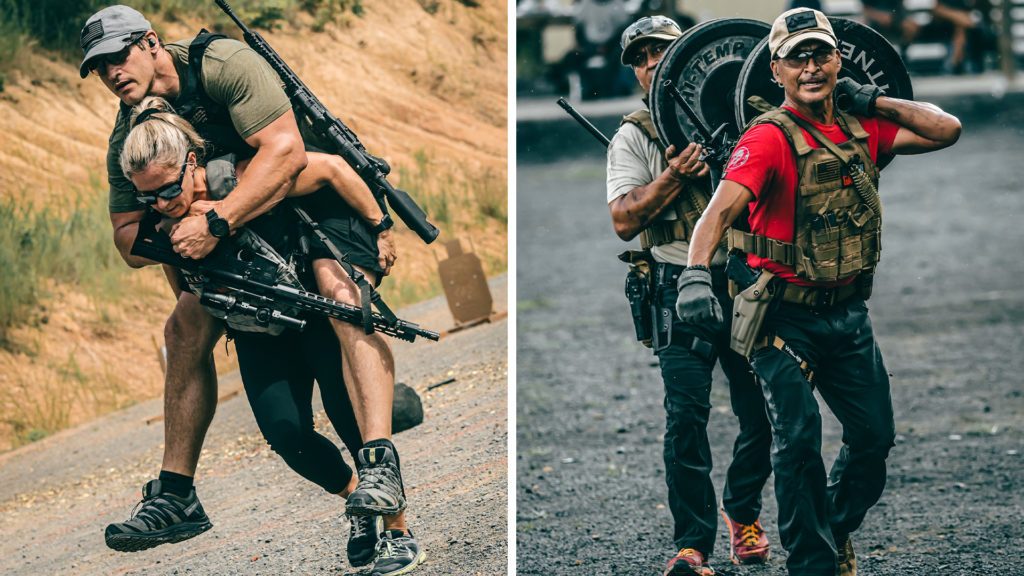Aug 24, 2022 What Are the Tactical Games?

It was only a matter of time before competitive shooting and physical fitness joined forces. A unique blend of endurance, marksmanship and strength, The Tactical Games tests “the skills and readiness of tactical athletes from all backgrounds.” A typical Tactical Games stage, or “battle” in the sport’s parlance, involves a fair amount of strenuous activity with the shooting.
After building a solid following in the military and law enforcement communities, along with civilians, now there are Tactical Games regionals conducted in Arizona, Iowa, Mississippi, Texas, West Virginia and more states, plus the national championship.
In a recent article from SSUSA.org writer John Parker caught up with Kirk Holmer, an enthusiast about the event who served 22 years of active duty in the Army and Utah Army National Guard to find out more about the tactical athletic event.
Below is an excerpt from the SSUSA.org article about The Tactical Games.
The genesis of the Tactical Games is—similar to many great endeavors—some friends getting together to make a fun idea a reality.
“The sport started back in 2019. A group of retired and active-duty military guys were talking trash about who was the best at shooting and fitness,” explained Holmer. “They decided to prove it, getting together in a farmer’s field for what military folks refer to as a ‘stress shoot.’ Seventeen individuals showed up for that first event. Tim Burke attended that match and recognized that they were on to something. He went on to found the Tactical Games.”
Not long after it started, the Tactical Games had taken on a life of its own.
Each Tactical Games competition consists of six battles spread over two days, focusing on three components of fitness: endurance, physical strength and stamina. In general, three battles a day, lasting about 12 minutes each, will test all three components.
Endurance battles can sometimes take longer, such as a 12-mile ruck lasting more than two hours. Rifle shooting ranges from five to 400 yards, with pistol targets mostly at 10 to 20 yards, sometimes reaching 85 yards. Scoring is mostly time plus penalties.
“It’s all about balancing the physical fitness and shooting aspects,” said Holmer. “So, there is a 10-second penalty for missed shots. In the Tactical Games, if you stink at shooting, but you’re good at fitness, you can’t beat somebody who is good at both.”
At the 2021 National Championship, one competitor was dominant physically with great raw times, but faltered on the shooting portions. The winner that year, Brandon Wyckoff, was good physically and also shot really well. That difference is what enabled him to reach the podium.
The physical challenges at early Tactical Games events were derived from military experiences, with tasks such as carrying water cans, ruck marches, running, etc., along with putting a few rounds down range during periods of elevated heart rate. More physical requirements were later added, such as carrying 150-pound sandbags, climbing ropes, obstacle courses and miles-long marches, that really upped the adrenaline and endorphin rush. With a 10-second penalty for missed shots, the ability to shoot well under duress is essential.
» ALSO SEE: How to Train Like Law Enforcement
“It is rare to shoot a clean stage in the Tactical Games,” said Holmer.
The Tactical Games gun requirements diverge from what many competitive shooters are familiar with. For starters, firearms must be carried on your person for the entirety of the match, which here means slung rifles and holstered pistols. AR-15s and derivatives are popular with Tactical Games competitors, with only .223 Rem., 5.56 mm NATO, .300 Blackout or 7.62×39 mm loads permitted, also no compensators or muzzle brakes. Initially, you only saw red dots on rifles with backup irons, but now scopes are allowed. On the pistol side, there were mostly Glocks, Smith & Wessons, etc., at the beginning, but as the sport started gaining steam, 3-gunners began to notice and competition guns such as Staccatos started showing up at matches. Acceptable pistol calibers are 9 mm, .40 S&W and .45 ACP.
There are also plate carrier weight requirements, 15 pounds for men and 12 pounds for women. Another thing to consider—you have to keep all of your firearms and gear safely retained while doing things like climbing ropes, carrying heavy sandbags or water jugs, and maneuvering around obstacles.
To read the full story from SSUSA.org about the Tactical Games, click here. To find out if there is an event coming to an area near you, visit the website here.


